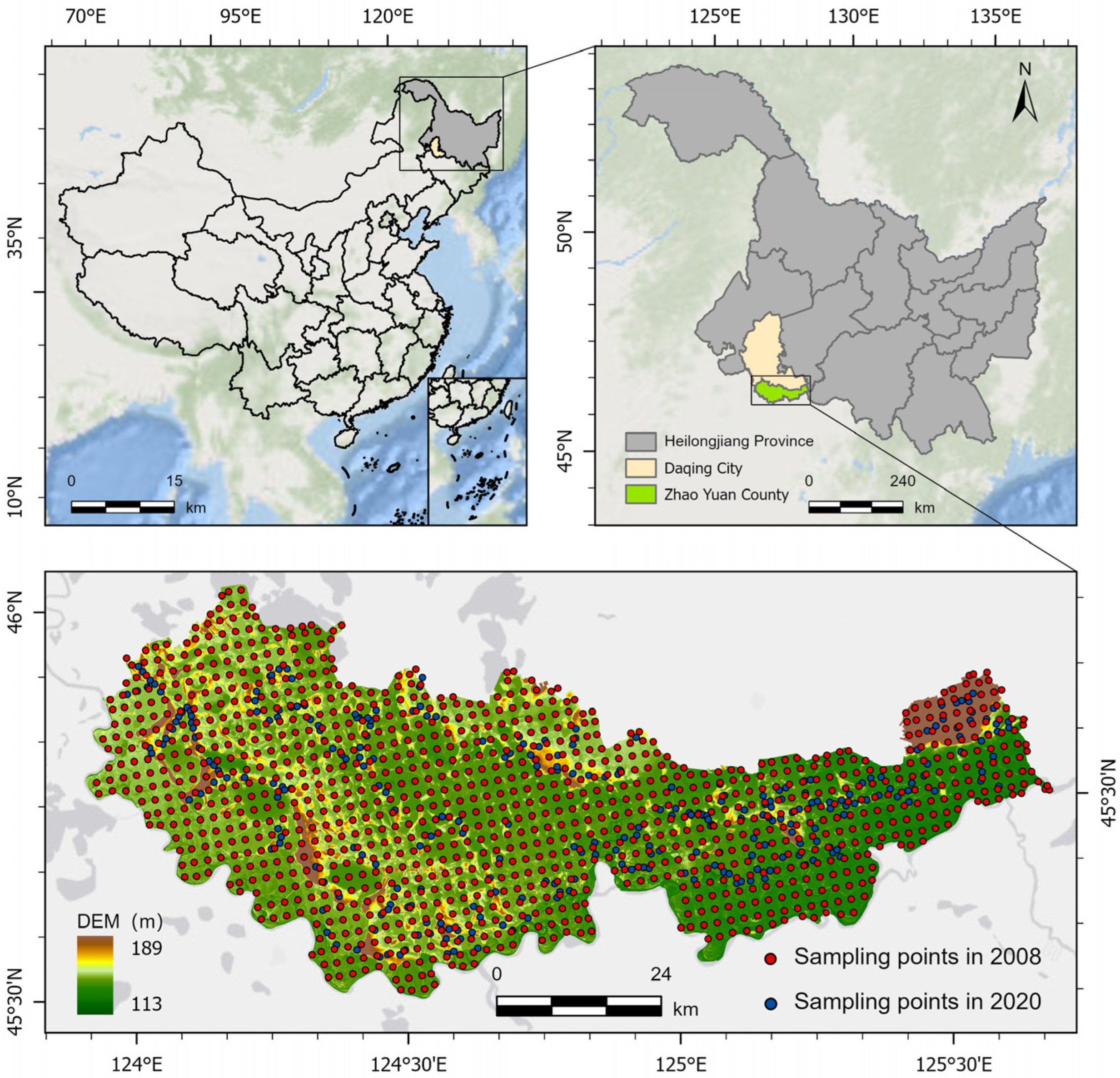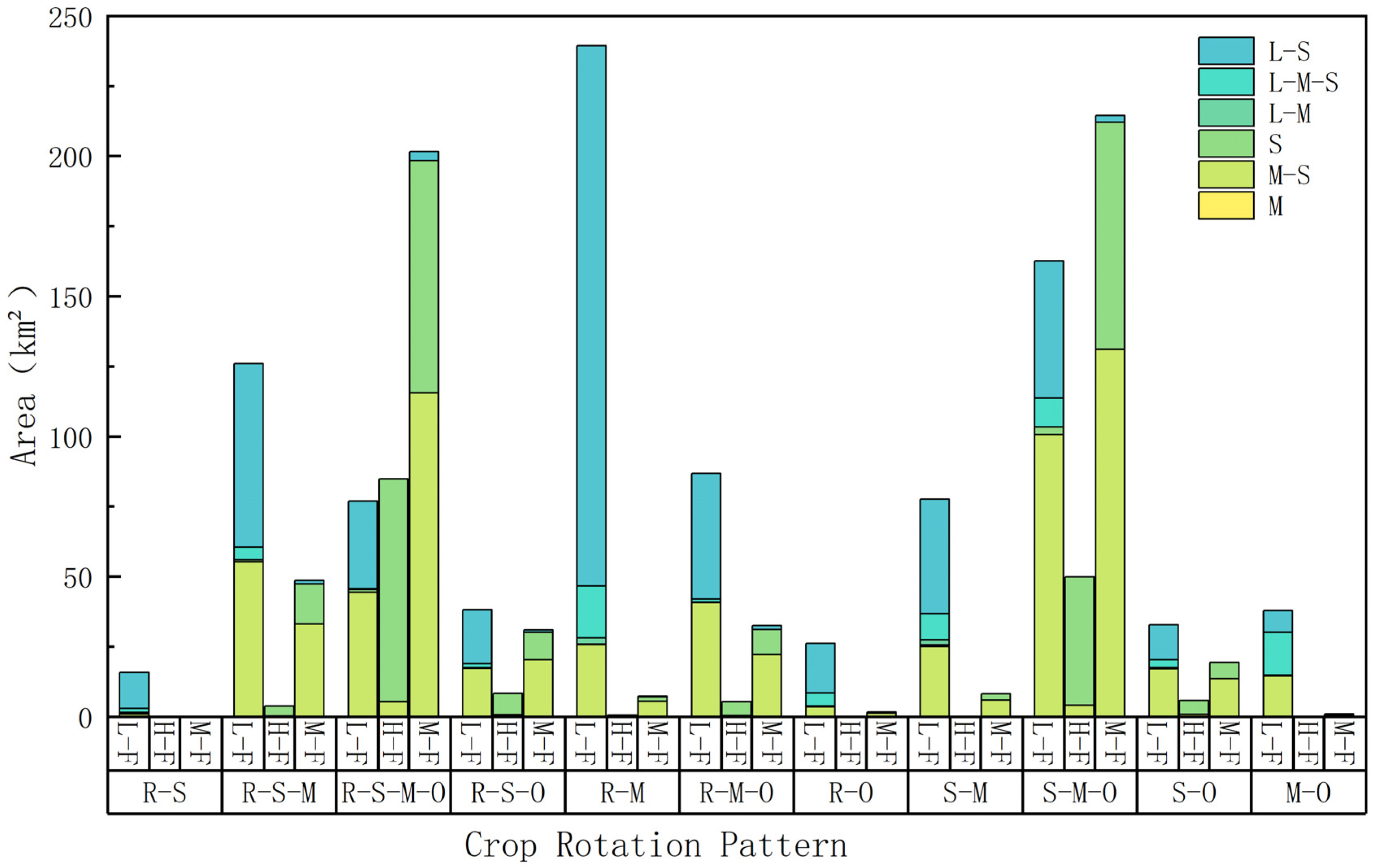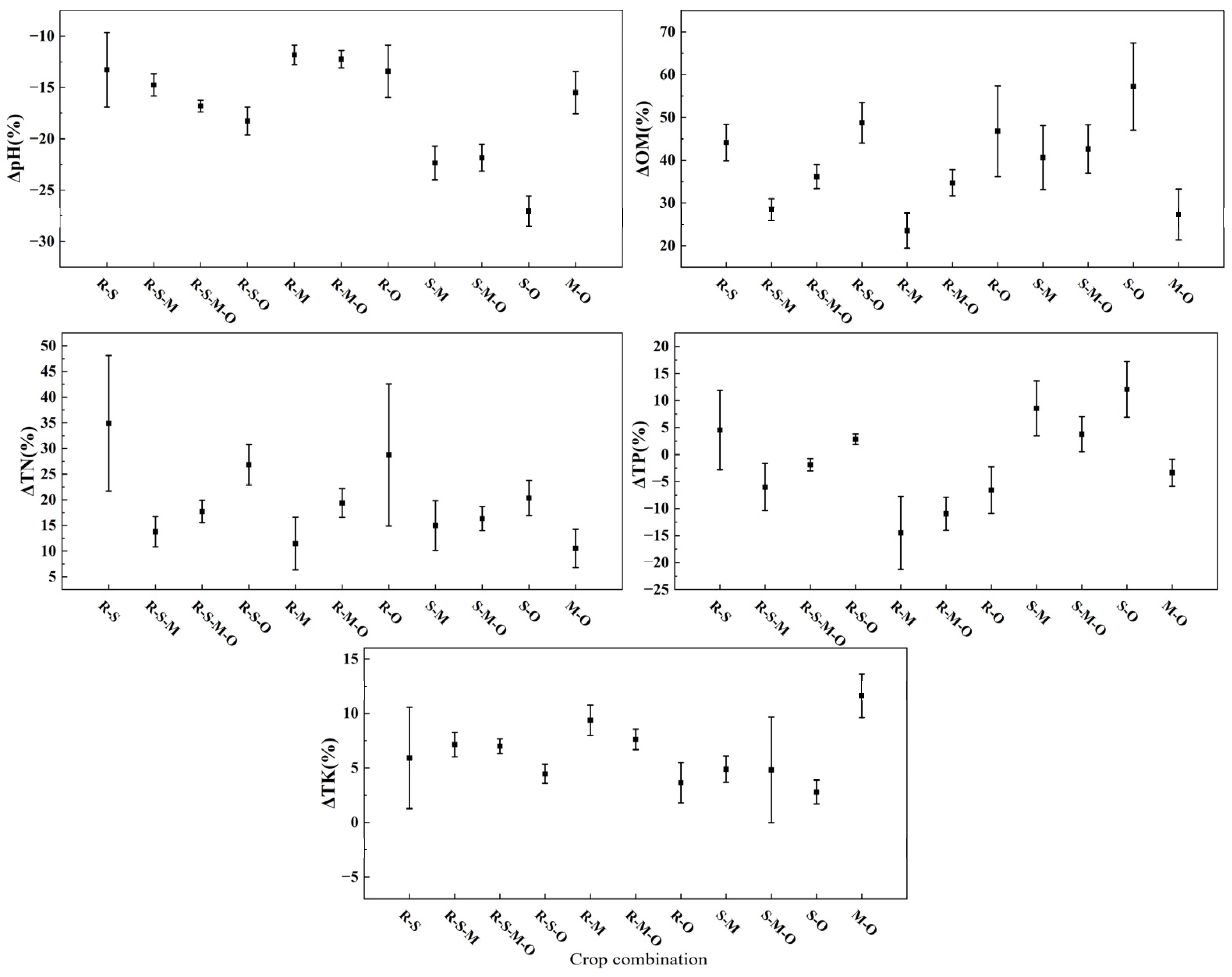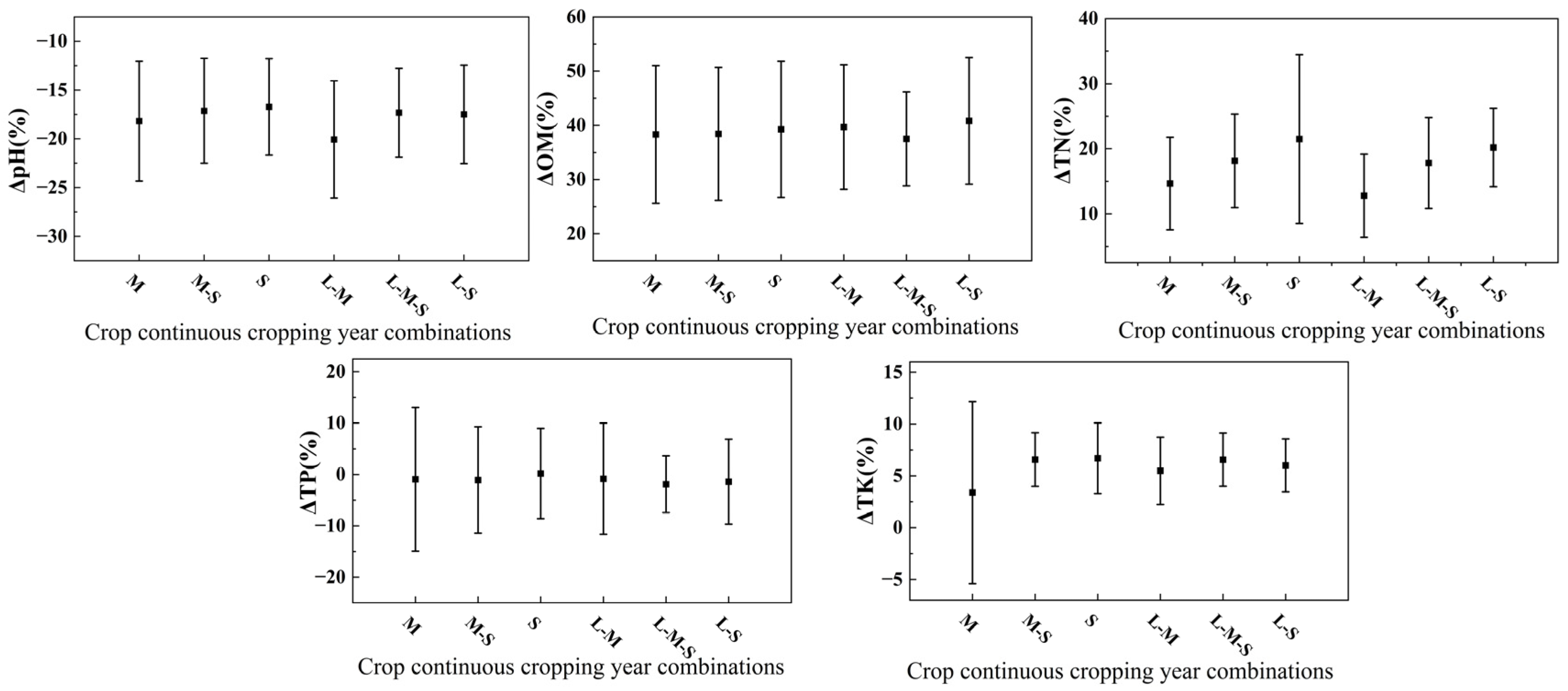Deconstruction of the Crop Rotation Pattern for Saline-Alkaline Land Based on Geo-Information Tupu and Assessment of Its Regulatory Effects on Soil Fertility
Abstract
1. Introduction
2. Data Sources and Research Methods
2.1. Overview of the Study Area
2.2. Data Sources and Preprocessing
2.2.1. Satellite Remote Sensing Data Sources and Preprocessing
2.2.2. Source of Soil Samples
2.3. Research Methods
2.3.1. Geo-Information Tupu
2.3.2. Geostatistical Methods
2.3.3. Fuzzy Comprehensive Evaluation Method
3. Results and Analysis
3.1. Crop Type Identification and Crop Rotation Pattern Classification
3.1.1. Evaluation of Crop Classification Accuracy
3.1.2. The Changes of Cultivated Area and Spatial Distribution Pattern of Different Crops in Zhaoyuan County from 2008 to 2020
3.1.3. Classification of Crop Rotation Patterns in Zhaoyuan County from 2008 to 2020
3.2. The Influence of Crop Rotation Patterns on Soil Chemical Properties
3.2.1. The Changes of Soil Chemical Properties and Spatial Distribution Patterns in Zhaoyuan County from 2008 to 2020
3.2.2. The Influence of Different Crop Combinations in Rotation Systems on Soil Chemical Properties
3.2.3. The Influence of Different Rotation Frequencies and Continuous Cropping Years in the Rotation System on Soil Chemical Properties
3.3. The Influence of Crop Rotation Patterns on Soil Fertility
3.3.1. The Changes of Soil Fertility and Spatial Pattern of Cultivated Land in Zhaoyuan County from 2008 to 2020
3.3.2. The Influence of Different Crop Combinations in the Rotation System on Soil Fertility
3.3.3. The Influence of Different Rotation Frequencies and Continuous Cropping Years in the Rotation System on Soil Fertility
4. Discussion
4.1. Classification of Crop Rotation Patterns
4.2. The Influence of Crop Rotation Patterns on the Chemical Properties of Cultivated Soil in Saline-Alkali Areas
4.3. The Influence of Crop Rotation Patterns on the Fertility of Cultivated Soil
4.4. Recommendations and Limitations
5. Conclusions
Author Contributions
Funding
Institutional Review Board Statement
Informed Consent Statement
Data Availability Statement
Acknowledgments
Conflicts of Interest
References
- Ajay, S. Soil salinity: A global threat to sustainable development. Soil Use Manag. 2021, 38, 39–67. [Google Scholar] [CrossRef]
- Minhas, P.S.; Ramos, T.B.; Ben-Gal, A.; Pereira, L.S. Coping with salinity in irrigated agriculture: Crop evapotranspiration and water management issues. Agric. Water Manag. 2020, 227, 105832. [Google Scholar] [CrossRef]
- Cuevas, J.; Daliakopoulos, I.N.; del Moral, F.; Hueso, J.J.; Tsanis, I.K. A Review of Soil-Improving Cropping Systems for Soil Salinization. Agronomy 2019, 9, 295. [Google Scholar] [CrossRef]
- Cao, W.; Gao, H.; Wang, X.; Chen, R.; Chai, C.; Liu, Z.; Zhao, X.; Liu, H. Effects of different fertilization measures on growth and yield of soybean in coastal saline-alkaline land. Jiangsu Agric. Sci. 2023, 51, 53–60. [Google Scholar] [CrossRef]
- Lian, F.; Zhang, F.; Wang, J. Vulnerability Assessment of Land-use under the Threat of Coastal Saline Alkali Area of Soil Salinization——A Case Study of Huanghua City in Hebei Province. J. Catastrophology 2015, 30, 209–215. [Google Scholar]
- Soda, N.; Ephrath, J.E.; Dag, A.; Beiersdorf, I.; Presnov, E.; Yermiyahu, U.; Ben-Gal, A. Root growth dynamics of olive (Olea europaea L.) affected by irrigation induced salinity. Plant Soil 2017, 411, 305–318. [Google Scholar] [CrossRef]
- Zhao, C.; Zhang, H.; Song, C.; Zhu, J.; Shabala, S. Mechanisms of Plant Responses and Adaptation to Soil Salinity. Innovation 2020, 1, 100017. [Google Scholar] [CrossRef] [PubMed]
- Xiao, W.; Wang, H.; Wang, M.; Wang, J. Mechanisms of Plant Response to Saline-alkali Stress: A Review. Chin. Agric. Sci. Bull. 2024, 40, 78–85. [Google Scholar]
- Wei, J.; Cai, Q.; Li, Y.; Shang, L.; Bu, X.; Yu, Z.; Ma, R. Research Progress on Response Mechanism of the Plant to Saline-Alkali Stress. Shandong Agric. Sci. 2022, 54, 156–164. [Google Scholar] [CrossRef]
- Wang, Q.; Deng, M.; Ning, S.; Sun, Y. Reality and problems of controlling soil water and salt in farmland. Adv. Water Sci. 2021, 32, 139–147. [Google Scholar]
- Food and Agriculture Organization of the United Nations. World Soil Day: FAO Highlights the Threat of Soil Salinization to Global Food Security. Available online: https://www.fao.org/newsroom/detail/world-soil-day-fao-highlights-threat-of-soil-salinization-to-food-security-031221/en (accessed on 5 July 2025).
- Liu, X.; Guo, K.; Feng, X.; Sun, H. Discussion on the agricultural efficient utilization of saline-alkali land resources. Chin. J. Eco-Agric. 2023, 31, 345–353. [Google Scholar]
- Cui, S.; Zhang, J.; Sun, M.; Chen, H.; Feng, Z. Leaching effectiveness of desalinization by rainfall combined with wheat straw mulching on heavy saline soil. Arch. Agron. Soil Sci. 2017, 64, 891–902. [Google Scholar] [CrossRef]
- Geng, Q.; Yan, H.; Yang, J.; Zhang, J.; Cheng, Y. Evaluation for Soil Improvement Effect of Open Ditch and Concealed Drainage Engineering on Saline Alkali Land Development. Chin. J. Soil Sci. 2019, 50, 617–624. [Google Scholar] [CrossRef]
- Wang, S.; Chen, Q.; Li, Y.; Zhuo, Y.; Xu, L. Research on saline-alkali soil amelioration with FGD gypsum. Resour. Conserv. Recycl. 2016, 121, 82–92. [Google Scholar] [CrossRef]
- Zhao, Y.; Wang, S.; Li, Y.; Liu, J.; Zhuo, Y.; Zhang, W.; Wang, J.; Xu, L. Long-term performance of flue gas desulfurization gypsum in a large-scale application in a saline-alkali wasteland in northwest China. Agric. Ecosyst. Environ. 2018, 261, 115–124. [Google Scholar] [CrossRef]
- He, K.; He, G.; Wang, C.; Zhang, H.; Xu, Y.; Wang, S.; Kong, Y.; Zhou, G.; Hu, R. Biochar amendment ameliorates soil properties and promotes Miscanthus growth in a coastal saline-alkali soil. Appl. Soil Ecol. 2020, 155, 103674. [Google Scholar] [CrossRef]
- Huang, J.; Shang, Y.; Chen, Y.; Xu, L.; Yang, Y.; Zhao, X. Analysis of Research Trends and Comprehensive Utilization Solutions for Saline–Alkali Land. Sustainability 2025, 17, 5202. [Google Scholar] [CrossRef]
- Tang, C.; Yang, J.; Xie, W.; Yao, R.; Wang, X. Effect of Biochar Application on Soil Fertility, Nitrogen Use Efficiency and Balance in Coastal Salt-Affected Soil under Barley–Maize Rotation. Sustainability 2023, 15, 2893. [Google Scholar] [CrossRef]
- Kumari, A.; Jha, B. Engineering of a novel gene from a halophyte: Potential for agriculture in degraded coastal saline soil. Land Degrad. Dev. 2019, 30, 595–607. [Google Scholar] [CrossRef]
- Chen, X.; Wu, J.; Opoku-Kwanowaa, Y. Effects of Returning Granular Corn Straw on Soil Humus Composition and Humic Acid Structure Characteristics in Saline-Alkali Soil. Sustainability 2020, 12, 1005. [Google Scholar] [CrossRef]
- Li, J.; Pu, L.; Han, M.; Zhu, M.; Zhang, R.; Xiang, Y. Soil salinization research in China: Advances and prospects. J. Geogr. Sci. 2014, 24, 943–960. [Google Scholar] [CrossRef]
- Yang, J.; Yao, R.; Wang, X.; Xie, W.; Zhang, X.; Zhu, W.; Zhang, L.; Sun, R. Research on Salt-affected Soils in China: History, Status Quo and Prospect. Acta Pedol. Sin. 2022, 59, 10–27. [Google Scholar]
- Liu, X. Reclamation and utilization of saline soils in water-scarce regions of Bohai Sea. Chin. J. Eco-Agric. 2018, 26, 1521–1527. [Google Scholar]
- Yun, P.; Gao, X.; Chen, L.; Lu, C.; Zhang, J.; Liu, R.; Wang, H.; Lin, G. Plant nitrogen utilization and soil nitrogen status in rhizosphere of maize as affected by various nitrogen rates in wheat-maize rotation system. J. Plant Nutr. Fertil. 2010, 16, 567–574. [Google Scholar]
- Zhang, J.; Wang, G.; Wu, B.; Jia, C.; Zhang, J.; Zhou, Y.; Ma, B. The Effects of Alfalfa-Triticale Rotation on Soil Bacterial and Fungal Community Diversity and Co-occurrence Network in Coastal Saline-Alkaline Soil. Ecol. Environ. Sci. 2024, 33, 1048–1062. [Google Scholar] [CrossRef]
- Liu, Q.; Zhao, Y.; Li, T.; Chen, L.; Chen, Y.; Sui, P. Changes in soil microbial biomass, diversity, and activity with crop rotation in cropping systems: A global synthesis. Appl. Soil Ecol. 2023, 186, 104815. [Google Scholar] [CrossRef]
- Yang, R.; Song, S.; Chen, S.; Du, Z.; Kong, J. Adaptive evaluation of green manure rotation for a low fertility farmland system: Impacts on crop yield, soil nutrients, and soil microbial community. Catena 2023, 222, 106873. [Google Scholar] [CrossRef]
- Wu, Y.; Wang, L.; Cui, Y.; Hao, X.; Wang, B.; Tian, X.; Li, X.; Qin, Y. Rice yield, quality, and soil fertility in response to straw incorporation and rotation pattern. J. Plant Nutr. Fertil. 2021, 27, 1926–1937. [Google Scholar]
- Guo, Y.; Cheng, M.; Zhao, X.; Hao, B.; Zhang, Y.; Cao, W.; Zheng, P. Effects of green manure rotation on soil properties and yield and quality of silage maize in saline-alkali soils. Chin. J. Eco-Agric. 2018, 26, 856–864. [Google Scholar] [CrossRef]
- Šeremešić, S.; Živanov, S.T.; Rajković, M.; Aćin, V.; Milić, S.; Babec, B.; Jovanović, S. Exploring Fungal Biodiversity in Crop Rotation Systems: Impact of Soil Fertility and Winter Wheat Cropping. Plants 2024, 14, 65. [Google Scholar] [CrossRef]
- Nuppenau, E.-A. Soil Fertility Management by Transition Matrices and Crop Rotation: On Spatial and Dynamic Aspects in Programming of Ecosystem Services. Sustainability 2018, 10, 2213. [Google Scholar] [CrossRef]
- Chongtham, I.R.; Bergkvist, G.; Watson, C.A.; Sandström, E.; Bengtsson, J.; Öborn, I. Factors influencing crop rotation strategies on organic farms with different time periods since conversion to organic production. Biol. Agric. Hortic. 2017, 33, 14–27. [Google Scholar] [CrossRef]
- Łukowiak, R.; Grzebisz, W.; Sassenrath, G.F. New insights into phosphorus management in agriculture—A crop rotation approach. Sci. Total Environ. 2016, 542, 1062–1077. [Google Scholar] [CrossRef]
- Cai, Y.; Hao, M. Effects of rotation model and period on wheat yield, nutrient uptake and soil fertility in the Loess Plateau. J. Plant Nutr. Fertil. 2015, 21, 864–872. [Google Scholar]
- Chen, S.; Yue, T.; Li, H. Studies on Geo-Informatic Tupu and its application. Geogr. Res. 2000, 19, 337–343. [Google Scholar]
- Lu, F.; Chu, Y.; Zhang, X. Spatiotemporal Knowledge Graph: Advances and Perspectives. J. Geo-Inf. Sci. 2023, 25, 1091–1105. [Google Scholar]
- Liao, K. The Discussion and Prospect for Geo-Informatic Tupu. J. Geo-Inf. Sci. 2002, 1, 14–20. [Google Scholar]
- Du, G.; Yao, L.; Han, L.; Bonoua, F. What Should Be Learned from the Dynamic Evolution of Cropping Patterns in the Black Soil Region of Northeast China? A Case Study of Wangkui County, Heilongjiang Province. Land 2023, 12, 1574. [Google Scholar] [CrossRef]
- Burgess, T.M.; Webster, R. Optimal interpolation and isarithmic mapping of soil properties: I The semi-variogram and punctual kriging. Eur. J. Soil Sci. 2019, 70, 11–19. [Google Scholar] [CrossRef]
- Wang, Y.; Huang, J.; Liu, K.; Han, T.; Du, J.; Ma, X.; Hao, X.; Zhou, B.; Liu, C.; Jiang, X.; et al. Evaluation and spatial variability of paddy soil fertility intypical county of northeast China. J. Plant Nutr. Fertil. 2020, 26, 256–266. [Google Scholar]
- Wang, Z.; Wang, S.; Xu, L.; Guo, Q.; Chen, Y.; Qiu, W.; Sun, J. Comparative Evaluation Methods of Comprehensive Soil Fertility in Jiangsu’s Coastal Saline–Alkali Land. Land 2025, 14, 469. [Google Scholar] [CrossRef]
- Zong, D.; Zhou, Y.; Zhou, J.; Zhao, Y.; Hu, X.; Wang, T. Soil microbial community composition by crop type under rotation diversification. BMC Microbiol. 2024, 24, 435. [Google Scholar] [CrossRef]
- Sara, R.; Amanda, C.; De Forest Whitney, B.; Bruce, L.; Luis, E.; Kassim, A.K.; Michelle, L.M.; Cameron, P. Crop Rotations in California Rice Systems: Assessment of Barriers and Opportunities. Front. Agron. 2022, 4, 806572. [Google Scholar] [CrossRef]
- Li, R.; Li, J.; Lin, S.; Xie, T.; Fan, P.; Wang, Q.; Li, T.; Wang, S. Effects of rice-soybean-rice rotation on soil physicochemicalproperties and microbial community. J. Trop. Biol. 2024, 15, 157–164. [Google Scholar] [CrossRef]
- Wang, Y.; Chen, X.; Shi, Y.; Lu, C. Review on the effects of low-molecular-weight organic acids on soil phosphorus activation and mechanisms. Chin. J. Ecol. 2018, 37, 2189–2198. [Google Scholar] [CrossRef]
- Li, D.; Huang, J.; Ma, C.; Xue, Y.; Gao, J.; Wang, B.; Zhang, Y.; Liu, K.; Han, T.; Zhang, H. Spatio-Temporal Variations of Soil Organic Matter in Paddy Soil and Its Driving Factors in China. Sci. Agric. Sin. 2020, 53, 2410–2422. [Google Scholar]
- Ou, Y.; Alain, N.R.; Wang, L.; Yan, B. Spatio-temporal patterns of soil organic carbon and pH in relation to environmental factors—A case study of the Black Soil Region of Northeastern China. Agric. Ecosyst. Environ. 2017, 245, 22–31. [Google Scholar] [CrossRef]
- Yang, F.; Xu, Y.; Cui, Y.; Meng, Y.; Dong, Y.; Ma, R.; Ma, Y. Variation of Soil Organic Matter Content in Croplands of China over the Last Three Decades. Acta Pedol. Sin. 2017, 54, 1047–1056. [Google Scholar]
- Pan, Y.; Wang, P.; Guo, Y.; Wang, Y.; Liu, S.; Zhang, Q.; Zhu, H.; Dai, L. Effects of Crop Allocation and Optimization of Fertilizer and Water on Crop Yield and Soil Nutrients under Paddy Rice-upland Crop Rotation. Southwest China J. Agric. Sci. 2018, 31, 276–283. [Google Scholar] [CrossRef]
- Zhang, S.; Ren, T.; Fang, Y.; Zhao, J.; Zhu, J.; Cong, W.; Lambers, H.; Lu, J. Enhancing soil labile organic matter through oilseed rape-rice rotation and straw returning in paddy-upland systems. Plant Soil 2025, 1–18. [Google Scholar] [CrossRef]
- Yang, W.; Luo, H.; Dong, E.; Wang, J.; Wang, Y.; Liu, Q.; Huang, X.; Jiao, X. Effects of Long-Term Fertilization and Deep Plough on Crop Potassium Utilization and Soil Potassium Forms in Maize-Sorghum Rotation System. Sci. Agric. Sin. 2024, 57, 2390–2403. [Google Scholar]
- Zhu, D.; Cong, R.; Ren, T.; Lu, Z.; Lu, J.; Li, X. Straw incorporation improved the adsorption of potassium by increasing the soil humic acid in macroaggregates. J. Environ. Manag. 2022, 310, 114665. [Google Scholar] [CrossRef]
- Zhang, X.; Yin, M.; Wang, Z.; Cheng, J.; Cheng, H.; Wang, W.; Yang, Y.; Wang, Y.; Su, Y.; Fu, L. Effects of long-term different green manure maize rotation on maize yield, nutrient absorption and soil fertility. Soil Fertil. Sci. China 2025, 17, 85–92. [Google Scholar]
- Dabessa, A.; Debala, C. Long-term soybean–maize rotation experiments in cereal-based farming systems at Bako, Western Ethiopia. Food Energy Secur. 2023, 12, e496. [Google Scholar] [CrossRef]
- Campbell, C.A.; Biederbeck, V.O.; Zentner, R.P.; Brandt, S.A.; Schnitzer, M. Effect of crop rotations and rotation phase on characteristics of soil organic matter in a Dark Brown Chernozemic soil. Can. J. Soil Sci. 1992, 72, 403–416. [Google Scholar] [CrossRef]












| Year | Time | Image Type | Strip Number | Line Number | Cloud Cover |
|---|---|---|---|---|---|
| 2008 | 09-07 | Landsat 5TM | 119 | 28 | 0.4 |
| 2009 | 08-09 | Landsat 5TM | 119 | 28 | 0.43 |
| 2010 | 08-12 | Landsat 5TM | 119 | 28 | 11.65 |
| 2011 | 07-14 | Landsat 5TM | 119 | 28 | 26 |
| 2012 | 08-09 | Landsat 7ETM+ | 119 | 28 | 0 |
| 2013 | 09-05 | Landsat 8OLI | 119 | 28 | 4.25 |
| 2014 | 08-07 | Landsat 8OLI | 119 | 28 | 1.02 |
| 2015 | 09-03 | Landsat 7ETM+ | 119 | 28 | 0 |
| 2016 | 08-28 | Landsat 8OLI | 119 | 28 | 1.73 |
| 2017 | 09-01 | Landsat 8OLI | 119 | 28 | 1.43 |
| 2018 | 09-19 | Landsat 8OLI | 119 | 28 | 0.41 |
| 2019 | 09-06 | Landsat 8OLI | 119 | 28 | 9.2 |
| 2020 | 07-14 | Landsat 7TM | 119 | 28 | 4 |
| Soil Fertility Evaluation Indicators | Inflection Points | Membership Function | Weights | |||
|---|---|---|---|---|---|---|
| X1 | X2 | X3 | X4 | |||
| pH | 5.5 | 6.5 | 7.5 | 8.5 | peak-type | 0.228 |
| OM (g/kg) | 6 | 40 | upper-limit type | 0.218 | ||
| TN (g/kg) | 0.5 | 2 | upper-limit type | 0.216 | ||
| TP (g/kg) | 0.2 | 1 | upper-limit type | 0.145 | ||
| TK (g/kg) | 5 | 25 | upper-limit type | 0.193 | ||
| Categorical Data | Verification Data | Total | User Accuracy % | |||
|---|---|---|---|---|---|---|
| Rice | Maize | Soybeans | Other Crops | |||
| Rice | 42 | 2 | 0 | 0 | 44 | 95.45 |
| Maize | 0 | 41 | 1 | 1 | 43 | 95.35 |
| Soybeans | 0 | 0 | 37 | 0 | 37 | 100 |
| Other crops | 0 | 0 | 4 | 42 | 46 | 91.30 |
| Total | 42 | 43 | 42 | 43 | 170 | - |
| Producer accuracy % | 100 | 95.35 | 88.10 | 97.67 | - | - |
| Planting Pattern | Number of Encoding Types | Proportion of Area |
|---|---|---|
| Continuous rice cropping (R) | 1 | 4.92% |
| Continuous soybean cropping( S) | 1 | 0.04% |
| Continuous maize cropping (M) | 1 | 2.42% |
| Rice–soybean rotation (R-S) | 349 | 0.90% |
| Rice–soybean–maize rotation (R-S-M) | 23,921 | 10.05% |
| Rice–soybean–maize–other crops rotation (R-S-M-O) | 124,598 | 20.46% |
| Rice–soybean–other crops rotation (R-S-O) | 12,935 | 4.36% |
| Rice–maize rotation (R-M) | 2230 | 13.92% |
| Rice–maize–other crops rotation (R-M-O) | 16,830 | 7.03% |
| Rice–other crops rotation (R-O) | 1253 | 1.57% |
| Soybean–maize rotation (S-M) | 2921 | 4.84% |
| Soybean–maize–other crops rotation (S-M-O) | 63,108 | 24.04% |
| Soybean–other crops rotation (S-O) | 2451 | 3.26% |
| Maize–other crops rotation (M-O) | 1211 | 2.19% |
| Indicator | Time | Range | Maximum | Minimum | Average |
|---|---|---|---|---|---|
| pH | 2008 | 5.40–10.89 | 10.89 | 5.4 | 8.95 |
| 2020 | 5.00–10.00 | 10 | 5 | 7.39 | |
| OM (g/kg) | 2008 | 1.38–51.55 | 51.55 | 1.38 | 16.69 |
| 2020 | 5.32–96.50 | 96.5 | 5.32 | 24.93 | |
| TN (g/kg) | 2008 | 0.10–2.90 | 2.94 | 0.1 | 1.06 |
| 2020 | 0.15–4.86 | 4.86 | 0.15 | 1.36 | |
| TP (g/kg) | 2008 | 0.19–1.85 | 1.84 | 0.19 | 0.46 |
| 2020 | 0.03–2.70 | 2.7 | 0.03 | 0.45 | |
| TK (g/kg) | 2008 | 17.68–31.12 | 31.12 | 17.68 | 23.45 |
| 2020 | 10.40–54.70 | 54.7 | 10.4 | 24.68 |
Disclaimer/Publisher’s Note: The statements, opinions and data contained in all publications are solely those of the individual author(s) and contributor(s) and not of MDPI and/or the editor(s). MDPI and/or the editor(s) disclaim responsibility for any injury to people or property resulting from any ideas, methods, instructions or products referred to in the content. |
© 2025 by the authors. Licensee MDPI, Basel, Switzerland. This article is an open access article distributed under the terms and conditions of the Creative Commons Attribution (CC BY) license (https://creativecommons.org/licenses/by/4.0/).
Share and Cite
Zhang, H.; Cheng, W.; Du, G. Deconstruction of the Crop Rotation Pattern for Saline-Alkaline Land Based on Geo-Information Tupu and Assessment of Its Regulatory Effects on Soil Fertility. Sustainability 2025, 17, 7430. https://doi.org/10.3390/su17167430
Zhang H, Cheng W, Du G. Deconstruction of the Crop Rotation Pattern for Saline-Alkaline Land Based on Geo-Information Tupu and Assessment of Its Regulatory Effects on Soil Fertility. Sustainability. 2025; 17(16):7430. https://doi.org/10.3390/su17167430
Chicago/Turabian StyleZhang, Hui, Wenhui Cheng, and Guoming Du. 2025. "Deconstruction of the Crop Rotation Pattern for Saline-Alkaline Land Based on Geo-Information Tupu and Assessment of Its Regulatory Effects on Soil Fertility" Sustainability 17, no. 16: 7430. https://doi.org/10.3390/su17167430
APA StyleZhang, H., Cheng, W., & Du, G. (2025). Deconstruction of the Crop Rotation Pattern for Saline-Alkaline Land Based on Geo-Information Tupu and Assessment of Its Regulatory Effects on Soil Fertility. Sustainability, 17(16), 7430. https://doi.org/10.3390/su17167430







